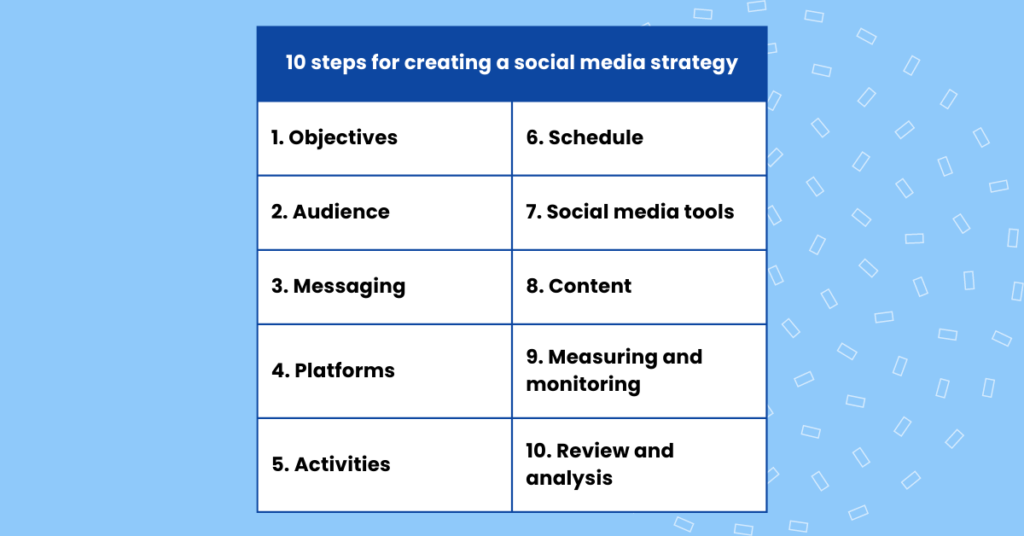A social media strategy is a requirement for any brand that wants to survive in the digital age. Whether you’re a sole practitioner, an international corporation, or anything in between, you need to be engaging with your audience where they interact. More than ever, that’s on social media.
A successful social media strategy will define your social media goals, the methods you plan to use, and the social media analytics you will collect in order to optimize over time.
Furthermore, a proper strategy will serve as your company’s road map to social media marketing success. In this blog, we’ll show you how to create an effective social media strategy that is goal-oriented, audience-focused, content-driven, and measurable.
Table of contents
Importance of social media marketing
Answering the question of “what is social media strategy?” is only the beginning. Understanding the critical nature of social media strategy for business is also important.
As it stands, 4.76 billion people currently have social media profiles, with the daily average usage at 2 hours and 30 minutes. In the United States, 84% of adults between the ages of 18-29 are active social media users, followed by 81% of adults between 30-49 years old. Today, 90% of people with a social media account use social networks to communicate with brands and businesses.
As a business looking to improve brand awareness, lead generation, and scale growth, social media management has to be a part of the overall strategy. The key to leveraging these customer-facing channels is developing a robust and effective strategy.

Understanding social media strategy and its benefits
Having a strategy provides you with the methods and plans for posting content on social media and lets you optimize those efforts in a way that generates results.
Why do you need a social media strategy?
A strategy is an overall plan to achieve a goal or objective. For businesses, this means making more money, improving customer satisfaction, and operating successfully in the marketplace. The worst type of strategy is no strategy at all. Like someone playing darts by choosing a random direction to throw, a business without a social media strategy will struggle to hit its target.
The advantage of a strategy is that it gives you a framework for taking action. Let’s dig into a few ways this can work.
Social media campaign marketing
A social media campaign is a marketing strategy that uses social media platforms to interact with your customers and prospects. It’s used primarily to increase brand awareness, drive sales, and help businesses achieve their goals. Social media campaign marketing includes activities such as creating content, monitoring key metrics, running paid advertising, and analyzing the results of campaigns to optimize future ones.
Committing to frequency
A successful strategy also requires a commitment to frequency. Consistently posting on your social media channels builds trust among your audiences. It’s an intentional tactic that keeps your brand visible and reputable by posting relevant content.
Drives your brand image
A strategy must align with your company’s brand image, reputation, and messaging. Having the strategy in place makes sure you only interact and engage through the lens of your brand identity and guidelines. That brand consistency reinforces your brand identity.
Content roadmap
The strategy will serve as a blueprint for all content and should align with the overall messaging of your marketing strategy. Addressing the problems of your target audience and providing value is key to engaging with followers.
Additional benefits
There are internal benefits to a properly developed strategy. Because it’s a detailed outline and plan, anyone can step in and keep up with daily and weekly postings. When primary members of your marketing team are unavailable, you can rely on the strategy to guide secondary team members to manage your channels.
Pro tip: Consider creating and scheduling posts ahead of time to avoid “radio silence” during those times when people might be out of the office or unavailable. Social media management software typically has the capabilities to automate posting as well as responding to comments or replies, so you don’t miss an opportunity.
Pillars of a social media strategy
Before creating your strategy, it’s best to identify the pillars of an effective strategy. These elements will support every process you include in your strategy.
Key components include:
- Foundation setting: Foundational components include setting social media goals, deciding on tactics, creating a social media audit schedule, selecting tools, and setting budgets.
- Content guidelines: You must also set a content strategy determining the types and frequency of posts you’ll share. This will align you with your brand identity so that content consistently resonates with your target audience.
- Governance: Your strategy should account for who’s going to what, staff turnover, and social media crises. This plan must cover the roles, core responsibilities, and contingency plans to prepare you for any situation.
- Performance tracking: The strategy must also define key metrics, measurement tools to use, and timelines for data and analytic reviews. This will help you determine which campaigns continue to be effective and when it’s time to implement changes.
By outlining your social media pillars at the start, you can then move on to further development, including the framework of the goals, methods, content, and execution processes.
Social media strategy framework

The next step is developing a framework. The framework will be the “bones” of your strategy. It’ll carve out specific paths for your social media marketing success.
Here are the six components of an effective framework:
1. Setting goals
The first step of your framework is goal-setting. It’s a must that you set clear-cut goals that address your social media mission and vision. Your goals should be realistic and S.M.A.R.T.: specific, measurable, accurate, relevant, and time-bound.
Also, make sure that you set both primary and secondary goals.
- Primary goals: These are goals that address your top priorities for your strategy.
- Secondary goals: These are stretch goals you hope to accomplish but not before the primary goals are achieved.
Pro tip: To help with goal setting, try structuring your goals using an inverted pyramid. Start with broader goals on top and narrow them down to more precise goals. Remember, the goals you outline should also be measurable using key performance indicators (KPIs) and metrics.
2. Target audience
Identifying your target audience is necessary for your social media success. This means researching the people who are most likely to use your products and services. Once you’ve successfully identified your target audience, you can group them into two categories:
- Valuable customers: To start, focus on your most valuable audience. These people will drive the most value from your social media investment.
- Aspirational customers: Ths refers to the customer base you want to nurture next. In other words, the target audience you want to focus on shortly.
You must define your target audience and create a buyer persona(s). Businesses can create a buyer persona by conducting market research, identifying common traits, developing a profile, validating the persona, and using it to inform marketing strategies. The process involves understanding the target audience’s demographics, behavior, motivations, and challenges, and creating a detailed profile of the ideal customer. The persona is continually refined based on feedback and evolving market trends.

3. Channel strategy
Knowing which social media channels to be present on is key in driving your social media marketing strategy. Creating an effective channel strategy demands four primary factors.
Select your primary channels
First, define your primary channels for both organic content and paid campaigns. You’ll focus most of your efforts on these channels to build your social media presence. If your top objective is customer engagement, make sure that you focus your resources and attention on the channels your target audience visits the most.
You’re likely familiar with these, but to be clear, primary channels include:
- X (Twitter)
Select your secondary channels
Next, you’ll want to decide on secondary channels. These are the platforms that your target audience might visit only from time to time. Don’t focus too much effort on these channels but stay up-to-date on the features these platforms offer. If your audience begins to show interest in these channels, you can adapt quickly.
Some examples of secondary social media channels include:
- Twitch
- Discord
- Slack
- Clubhouse
- Nextdoor
Channel features
A channel content strategy must consider specific engagement and performance features for each platform. For example, Facebook’s features like Stores, Marketplace, Shops, Stories, and Messenger have grown in daily usage and require attention. A good rule of thumb is that if a channel offers a unique feature, develop a use case and strategy to use it.
For example, Instagram released its Reels feature to boost reach and unlock new user opportunities. Developing Reels would be a good idea for content distribution and reach if a business is active on Instagram.
Audience growth
Finally, your channel strategy should set a plan to grow your audience and presence. From invites to likes to engagement groups and proactive following, look to grow your audience using different strategies.
Some companies find success with employee and community spotlight posts, while others gain traction with posts featuring “behind the scenes” elements. Another social media strategy example includes “ask me anything” (AMA) posts and contests that drive engagement and responses. Get creative, and don’t be afraid to experiment to see what works best for your business.
Some audience growth strategies include:
- Using the Facebook Invite feature on targeted posts.
- Proactively commenting on accounts with high relevance.
- Polling your audience to prompt quick engagement.
- Getting shares, tags, shoutouts, and mentions from influencers.
In addition, get your employees involved by asking them to share and comment on company posts. This will increase the visibility of the content to improve impression rates.
4. Designing the content strategy
An effective social media content strategy structures the content plan and helps map out what you’ll publish across your channels. Your content strategy is a blueprint for organizing one-off campaigns and structuring your overall messaging efforts.
It’s important to note that incorporating a social media content strategy into your framework has two main benefits. First, you can plan and produce content in batches, saving time and ensuring consistency in messaging. Secondly, you can identify themes that resonate best with your target audience in your social media content strategy.
Your social media content strategy should also follow these actions:
- Plan your content strategy
- Know your content distribution approach
- Build your social media content calendar
- Promote and distribute your content
- Measure the results
Your content strategy is the heartbeat of your social media marketing plan. So, ensure it’s focused and provides value to your target audience.
In addition, you can enhance your content by specifically using social media engagement posts. Social media engagement posts refer to interactive and compelling content that helps you engage more with your target audience. Examples of engaging posts may include videos, polls, infographics, and discussions.
5. Optimize your content distribution
Optimizing your content distribution is another key element for a social media content strategy. There are three ways to accomplish this: paid social media, influencer marketing, and earned social media.
- Paid social media—This tactic allows you to reach your audience faster and more effectively. However, unlike organic posts, you will need a budget to use paid social media because, as its name suggests, it’s not free.
- Influencer marketing – This involves partnering with social media influencers to promote your content and increase its reach. Having a brand advocate validate your product or service will build trust faster.
- Earned social media – This is the organic promotion of your content through sharing, commenting, and liking. This helps increase your posts’ visibility to expand your audience base.
These three strategies will help you optimize your content distribution and boost engagement on your channels.
6. Executing the plan
Executing a social media plan involves several key functions that help businesses achieve their marketing goals and engage with their audience effectively. These functions include:
- Creating and curating content: Businesses must create and curate relevant and engaging content for their social media platforms to attract and retain their audience’s attention.
- Scheduling and publishing posts: Social media managers must schedule and publish posts at the right time and frequency to maximize engagement and reach.
- Engaging with followers: Engaging with followers through comments, direct messages, and social media groups can help businesses build relationships and improve brand loyalty.
- Monitoring and responding to feedback: Social media managers must monitor their platforms for feedback and respond promptly to negative comments or reviews.
- Analyzing performance: Measuring and analyzing social media performance helps businesses understand their audience’s behavior and optimize their strategies for better results.
Adapting to trends and changes: Keeping up with social media trends and changes in algorithms and policies helps businesses stay relevant and adjust their strategies accordingly.
10 steps for creating a social media strategy

Creating a strategy can be straightforward if you have a clear understanding of your desired marketing goals. Understanding how to create an effective social media strategy starts with a few core components.
It should provide direction about your target audience, content types, and appropriate platforms. The strategy should also address posting frequency and how to track and measure performance.
Here are 10 steps to consider when creating a strategy for social media.
1. Objectives
The first step is defining your goals and ensuring they’re measurable and achievable. Common, measurable objectives include brand awareness, purchase behavior, acquisition rates, conversions, and video views. Ensure everyone understands the goals and objectives so your social media marketing process is a success.
2. Audience
The second step is defining your audience and mapping out buyer personas, as discussed earlier. To get a good understanding of their personas, ask yourself:
- Which platforms do they use the most?
- How do they use these features – comment, like, share, etc.?
- What interests are they spending more time researching?
Knowing your audience’s persona will help you determine your content and channel strategies.
3. Messaging
This step involves nailing down your primary messaging, including “who you are as a brand” and “what you do.” The answers to questions like these can then be condensed into short and snappy messages that attract viewership and help communicate your brand concisely.
4. Platforms
Define which social media channels are best to communicate your message. If you’re more visually focused, Facebook and Instagram will better suit your needs. Whereas if you are creating more long-form content then perhaps LinkedIn is best. Remember that you should craft your content to the platforms your audience frequents the most. You could have the best content in the world but if your audience is elsewhere, it won’t matter.
5. Activities
Defining your social media activities helps you narrow down your content strategy. You should decide which activities are most important to reach your objectives and how they will be supported. To successfully define your strategic activities, first, take one objective and define a list of steps and activities you’ll undertake to meet this particular objective. Understanding and outlining your actions will help you understand how to develop a social media stratgy, and execute that strategy according to plan.
6. Schedule
Next, it’s important to schedule your social media activities quarterly at the very least. Identify significant dates that resonate with your brand. For example, look at holidays and events that help tell your story. Decide when to run specific activities, and be sure to monitor these activities to make sure they’re still relevant.
7. Social media tools
Social media management tools can be incredibly useful for elevating your social media presence. From automation and messaging services to video logs, widgets, tags, and analytics – these tools provide many opportunities for businesses to increase sales, build customer loyalty, and spread awareness. These tools are especially useful when juggling multiple accounts or multiple locations. If you have the budget, look into social media management tools that will help you to curate, schedule, and measure your social media efforts.
8. Content
Content creation is the most important step. Identify content relevant to your target audiences and ensure these different types are high quality to attract more engagement.
In addition, think about content strategy:
- What types of keywords are people searching for?
- How do I optimize my content for search engine optimization (SEO)?
- Can I create evergreen content that will continue to convert?
- How can I take advantage of user-generated content (i.e. customer reviews)?
- How can I repurpose content for multiple uses?
Having a content strategy in place is essential to ensure that you’re always creating fresh and interesting content, while also staying on-brand.
9. Measuring and monitoring
While rolling out your social media campaigns, ensure you’re continually measuring and monitoring your results to identify the most effective approach. Rather than just posting your content, revisit it to see what worked and what didn’t using social media analytics. Then adjust your strategy accordingly or enjoy the fruits of your labor. Another social media trick that works is split testing, also known as A/B testing.
A/B testing involves creating content into two versions and testing to see which ignites the most engagement.
10. Review and analysis
Make sure you review your content across different channels on a regular basis. Analyze your results by looking at your social media insights, sales data, and website traffic so that campaigns can succeed.
Find patterns that drive your content and use them to fine-tune your content marketing strategy.It’s important to remember that any successful social media campaign requires consistent effort and optimization. This can be a lot of work, but the potential rewards are worth it.
[Free Template] Social Media Marketing Strategy
Download Now
Reviewing your social media marketing strategy
Once you’ve developed your strategy, reviewing it and verifying every element is accounted for is best. It should be comprehensive and scalable.
Verify that it answers the question: why do you need a social media strategy? Ideally, your finished product should outline its purpose and intended results.
The more specific the plan, the more effective it’ll be in achieving your goals. Using a social media strategy template can help you organize your strategy faster and spark ideas you might not have thought of.
Consider the following as a checklist for reviewing your strategy to make sure it achieves the following:
- Creates a personalized experience with your target audience.
- Create a community for your audience.
- Uses brand advocates – followers and influencers promoting your brand.
- Creates profiles on relevant channels.
- Follows the designated social media budget.
- Runs cross-channel campaigns.
- Tells compelling stories through live features.
FAQs about social media strategy
Common social media strategies include personalizing your messaging, creating a community for your audience, using diversified content types, and having a presence on multiple platforms.
The five steps to creating a social media strategy include: establishing your goals and objectives, platform research, identifying your target audience, budget planning, and developing a content strategy.
Good social media strategies involve creating content that is engaging and relevant to your target audience, building relationships with customers and influencers, using paid campaigns to amplify reach, monitoring engagement metrics, responding quickly to comments and questions, optimizing posts for search engine optimization (SEO), staying up to date on trends, testing different strategies, and evaluating the success of campaigns.
The three core elements of a social media strategy are goal-setting, content creation, and analytics. Goal-setting involves determining what you want to accomplish with your social media campaigns. Content creation involves creating engaging and relevant content that resonates with your target audience. Analytics is used to track campaign performance and measure the performance of campaigns.
Drive social media success with Birdeye Social
Social media continues to be a vital component of any digital marketing strategy. It can help a company increase brand visibility and improve its online reputation management.
Birdeye Social is a social media management software that can help you with all aspects of your social media strategy. You can:
- Publish and monitor content from all your favorite social media platforms in one place [easy to use and manage multiple platforms]
- Schedule posts ahead of time to avoid radio silence [saves time and ensures consistent posting]
- Respond to comments and replies so you don’t miss an opportunity [improves customer service]
- Use social media analytics to track your results and identify the most effective approach [helps you measure success and optimize your strategy]
With Birdeye Social, you can publish and monitor your content from your favorite social media platforms like Facebook, LinkedIn, and Instagram all from a single platform.
The only social media software for multi-location businesses
Want to see the impact of Birdeye on your social media strategy? Watch the Free Demo Now.
This blog post is part of our Social Media Management Guide
Originally published









